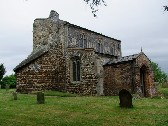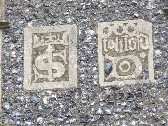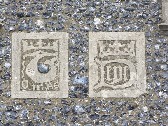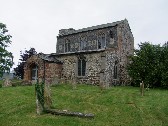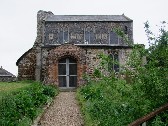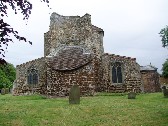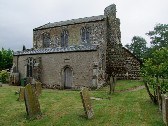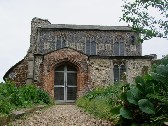| |
|
St
Nicholas, Feltwell
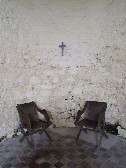 |
|
This
pretty little jewel of a church is set on the
edge of Feltwell, one of those large, working
villages which are a feature of south-west
Norfolk. It is certainly the prettiest little
thing in town, but thanks to the presence of the
grand, beautiful church of St Mary a quarter of a
mile off in the centre of the village, this
church was declared redundant in the early 1970s.
It is now in the care of the Churches
Conservation Trust. I couldn't help thinking
that, in these days of falling Anglican
attendances and rising maintenance costs, the
parish might rather have wished that they'd
declared the other one redundant and kept this
one in use instead. But be that as it may, it is
still of benefit to those of us who are pilgrims
and strangers of a spiritual bent, those of us
who might be looking for a cool, worshipful space
in the middle of a busy day, because of course
Feltwell has two of them, and they are both open
daily. You don't have to be an
architectural historian to see at a glance what
has happened here. This church was considerably
extended towards the end of the medieval period
with aisles and a clerestory, but since that time
the tower has fallen and the chancel has vanished
completely.
|
The
chancel was demolished in the 1860s, not a common way of
preparing a church for the Victorian Anglican revival,
but also not unknown elsewhere in Norfolk. The demolition
was apparently carried out by Frederick Preedy, who was
working on the restoration of St Mary at the time. I
wonder if he was looking for building materials. The
carstone round tower was still standing then. It must
have been similar to the one at Bexwell, not far off. But
it collapsed one night in 1898.
Perhaps
the most striking feature of the building is the set of
six flushwork panels, four with monograms, picked out in
stone on the south side of the clerestory. Presumably,
the monograms refer to 15th Century donors - those to the
east appear to read Tomas Deye. Inside the
church is a fragment of a memorial bearing an inscription
to a Robert Dey, who died in 1698, and might possibly be
a descendant. The other two are more mysterious: one is
probably a crowned ST for St Thomas, but what is the one
with smaller letters above a large capital D?
The
churchyard is strangely long and narrow, the church set
at the extreme west end of it. This was never a big
church, and the mixture of flint, freestone, carstone,
red brick and (on the north side) yellow brick gives it a
character quite unlike that of any other church in
Norfolk. You step into a large, square space, as wide as
it is long. There is little coloured glass, but there is
only one window in each of the aisle walls. This gives a
curious effect, with light shed into the building from
small windows to east and west, but mostly from above, in
the delicious clerestory. This creates a luminosity in
the upper white walls, almost a theatrical effect, and a
sense that this really is a place apart. The atmosphere
is utterly charming: this is a church which has not
changed much at all since the nineteenth century. It is a
memory of our Victorian rural ancestors, who would not be
out of place here even now in this dusty silence filled
with slanting light.
| Beneath
the tower, two chairs sit beneath a cross,
uncannily like a confessional. The grand Norman
tower arch has survived, and the two arcades are
quite out of kilter with each other, one being
elegantly Early English, the other blockish
late-Perpendicular. The simple sanctuary appears
wider than it is, thanks to the breadth of the
east wall. Mortlock mentions the cross, carved by
a prisoner of war when this church was used for
Catholic Masses by POWs during the Second World
War. After the fall of the tower the five
bells were melted down, but three of their
clappers survive, and are set on the west wall
beside a verse. It concludes: ...we called
you from your cottages and from the old Fen
shore; with lofty tower one morn we fell in
Eighteen Ninety Eight, no more we'll call you to
your prayers for silence is our fate. And
that precious silence lives on for us today.
|
|
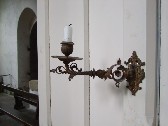 |
|
|
|

